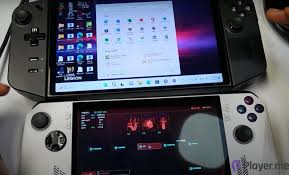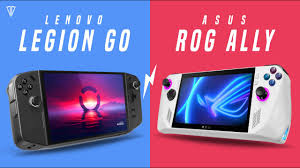Hey there, gamers! If you’re on the hunt for a handheld that can keep up with your gaming obsession, you’ve probably stumbled across the Lenovo Legion Go and ASUS ROG Ally. These two powerhouses are shaking up portable gaming, and picking between them feels like choosing your favorite superhero—each has its own epic strengths! If you’re blasting through epic battles on the couch or sneaking in a quick session on the go, we’ve got the full scoop on their specs, performance, screens, comfort, and more. Let’s dive in and figure out which one’s your perfect player two—trust me, by the end, you’ll be ready to hit “start” on the right choice!
Specifications
| Specification | Lenovo Legion Go | ROG Ally |
|---|---|---|
| Processor | AMD Ryzen Z1 Extreme | AMD Ryzen Z1 |
| RAM | 16GB LPDDR5 | 16GB LPDDR5 |
| Storage | 512GB SSD (expandable) | 512GB SSD (expandable) |
| Graphics | AMD RDNA 3 | AMD RDNA 3 |
| Display | 8.8-inch, 2560 x 1600, 144Hz refresh rate | 7-inch, 1920 x 1080, 120Hz refresh rate |
| Battery | 49.2 Wh, Removable | 40 Wh |
| Ports | USB-C, HDMI, headphone jack, SD card slot | USB-C, HDMI, headphone jack |
| Operating System | Windows 11 | Windows 11 |
| Price | Starts at $799.99 | Starts at $699.99 |
How Powerful Are They?
Both the Lenovo Legion Go and ROG Ally are built for gaming, running on AMD’s Ryzen Z1 series processors with RDNA 3 graphics. The Legion Go, though, has the edge with the Ryzen Z1 Extreme, a beefier chip that shines when you’re playing demanding titles like Cyberpunk 2077 or Elden Ring. It’s got the muscle to push higher frame rates and handle intense graphics settings better. With 16GB of RAM and a 512GB SSD, both devices keep things snappy—loading games fast and letting you juggle multiple tasks without a hitch.
The ROG Ally, with the standard Ryzen Z1, isn’t quite as powerful but still holds its own. It’s perfect for 1080p gaming and handles most modern games smoothly, especially if you’re not cranking every setting to ultra. For casual gamers or those on a tighter budget, it’s more than enough. Think of it as a reliable workhorse that gets the job done without breaking a sweat.
Related: Lenovo Legion Go vs Steam Deck
Which Has the Better Screen?
The display can make or break your gaming experience, and here’s where the Legion Go flexes its muscles. Its 8.8-inch screen is a stunner—2560 x 1600 resolution and a buttery-smooth 144Hz refresh rate. That means sharper visuals and fluid motion, whether you’re racing through Forza Horizon 5 or dodging attacks in DOOM Eternal. It’s bigger and bolder, pulling you right into the action.
The ROG Ally, meanwhile, rocks a 7-inch screen at 1920 x 1080 with a 120Hz refresh rate. It’s smaller and less pixel-packed, but don’t sleep on it—it’s still crisp, colorful, and smooth. For a handheld, it strikes a great balance, especially if you’re playing less demanding games or just want something that’s easier to carry. The Legion Go wins for immersion, but the Ally’s screen is no slouch.

How Comfortable Are They?
Gaming for hours? Comfort matters. The Lenovo Legion Go feels like it was made for long hauls. It’s a bit chunkier, sure, but that extra size comes with ergonomic handles and detachable controllers you can tweak to fit your style. It’s like holding a mini console—your hands won’t cramp up, even after a marathon session. The modular design is a bonus if you love customizing your setup.
The ROG Ally goes the opposite route: it’s lighter and more compact, perfect for tossing in a bag and gaming on the fly. It’s comfy for quick bursts—say, a commute or a lunch break—but the smaller size might feel a little tight during extended play. If you’re all about portability, the Ally’s sleek vibe is a win; if you want a cozy grip for hours, the Legion Go has you covered.
What’s the Software Like?
Both run Windows 11, which is a big deal—it opens the door to pretty much any PC game you can think of, from Steam to Epic Games to Xbox Game Pass. The Legion Go comes with Lenovo Vantage, a handy tool for tweaking performance, optimizing games, and keeping an eye on your system. It’s straightforward and does the job, especially if you like fine-tuning.
The ROG Ally brings ASUS’s Armoury Crate to the party. It’s a gamer’s dream—think performance tweaks, game library management, and even some cool RGB lighting controls. It’s slick and intuitive, giving you a bit more of that “gaming rig” feel. Both setups are solid, but Armoury Crate edges out slightly for its polish and gaming focus.
How Long Does the Battery Last?
Battery life is where portable gaming can hit a snag. The Legion Go’s 49.2 Wh battery gives you about 3-5 hours, depending on how hard you’re pushing it—lighter games stretch it longer, heavy hitters drain it faster. The real kicker? It’s removable. Pop in a spare, and you’re back in action without hunting for a charger. That’s a game-changer for road warriors.
The ROG Ally’s 40 Wh battery clocks in at 3-4 hours. It’s decent—enough for a few levels or a movie—but it’ll tap out quicker on intense games. No swapping here, so you’ll need a power bank or outlet nearby for longer sessions. The Legion Go takes the crown for flexibility, though neither is a marathon champ.
What About the Price?
Money talks, right? The ROG Ally starts at $699.99, making it the wallet-friendly pick. For that price, you’re getting strong performance and a portable package—great value if you don’t need the absolute top tier.
The Legion Go, at $799.99, costs more but brings extras like the beefier processor, bigger screen, and that removable battery. It’s a premium choice, and the price reflects the added perks. If you’ve got the cash and want the full package, it’s worth it; if you’re pinching pennies, the Ally delivers without breaking the bank.
Which One Should You Buy?
Go for the Lenovo Legion Go if:
- You crave a big, gorgeous screen with high resolution and a 144Hz refresh rate.
- You need max power for the latest, toughest games (thanks, Ryzen Z1 Extreme).
- Comfort and customization matter for long gaming stretches.
- A swappable battery sounds like a lifesaver.
Choose the ROG Ally if:
- You want something light and easy to carry anywhere.
- You’re after a solid deal that still plays most games well.
- Short, on-the-go sessions are your vibe.
- You dig ASUS’s premium build and RGB flair.
Final Thoughts
The Lenovo Legion Go and ROG Ally are both awesome in their own ways. The Legion Go is your go-to if you’re chasing top-notch performance, a killer display, and a comfy, customizable feel—it’s like a portable gaming throne. The ROG Ally, though, nails it for portability, affordability, and a sleek, no-fuss design—perfect for gamers who want to keep it simple and light.
It all boils down to what you value most: raw power and immersion or convenience and cost. Either way, you’re getting a fantastic handheld that’ll keep you gaming wherever life takes you. What’s your pick?

